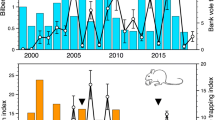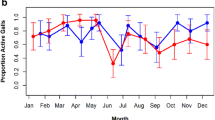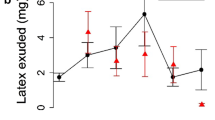Abstract
The mast depression hypothesis has been put forward to explain the 9- to 10-year population cycle of the autumnal moth (Epirrita autumnata; Lepidoptera: Geometridae) in northern Fennoscandia. We analysed long-term data from Finnish Lapland in order to evaluate the critical assumption of the mast depression hypothesis: that better individual performance of herbivores, followed by high annual growth rate of populations, occurs in the year following mast seeding of the host, the mountain birch (Betula pubescens ssp. czerepanovii). Since mast seeding has been suggested to occur at the expense of chemical defence against herbivores, we bioassayed the quality of birch leaves from the same trees by means of yearly growth trials with autumnal moth larvae. We also measured the size of wild adults as a determinant of potential fecundity of the species in different years. The relative growth rate of larvae was poorer in post-mast years compared to other years, rather than better as assumed by the hypothesis. Conversely, a slight indication of the increase in potential fecundity was observed due to the somewhat larger adult size in post-mast years. Population growth rate estimates, however, showed that the increase in fecundity would have to be much higher to facilitate population increase towards a cyclic peak with outbreak density. Accordingly, our two data sets do not support the assumption of a higher annual growth rate in autumnal moth populations subsequent to mast seeding of the host, thereby contradicting the predictions of the mast depression hypothesis. Temperatures, when indexed by the North Atlantic Oscillation and accumulated thermal sums, were observed to correlate with the abundance or rate of population change of the autumnal moth. The factors underlying the regular population cycles of the autumnal moth, however, remain unidentified. Overall, we suggest that the causal agents in cyclic insect population dynamics should be clarified by field experimentation, since trophic interactions are complex and are further modified by abiotic factors such as climate.





Similar content being viewed by others
References
Ayres MP, MacLean SF Jr (1987) Development of birch leaves and the growth energetics of Epirrita autumnata (Geometridae). Ecology 68:558–568
Berryman AA, Stenseth NC, Isaev AS (1987) Natural regulation of herbivorous forest insect populations. Oecologia 71:174–184
Box GEP, Jenkins GM (1976) Time series analysis: forecasting and control. Holden Day, San Francisco, Calif.
Bylund H (1995) Long-term interactions between the autumnal moth and mountain birch: the roles of resources, competitors, natural enemies, and weather. PhD thesis. Swedish University of Agricultural Science, Uppsala
Dahl Å, Strandhede S–O (1996) Predicting the intensity of the birch pollen season. Aerobiologia 12:97–106
Gross HL (1972) Crown deterioration and reduced growth associated with excessive seed production by birch. Can J Bot 50:2431–2437
Hanhimäki S, Senn J (1992) Sources of variation in rapidly inducible responses to leaf damage in the mountain birch–insect herbivore system. Oecologia 91:318–331
Haukioja E (1982) Inducible defences of white birch to a geometrid defoliator, Epirrita autumata. In: Visser JH, Minks AK (eds) Proceedings of the 5th International Symposium on Insect-Plant Relationships. Pudoc, Wageningen, pp 199–203
Haukioja E (1990) Induction of defenses in trees. Annu Rev Entomol 36:25–42
Haukioja E (1991) Cyclic fluctuations in density: interactions between a defoliator and its host tree. Acta Oecol 12:77–88
Haukioja E, Neuvonen S (1985) The relationship between size and reproductive potential in male and female Epirrita autumnata (Lep., Geometridae). Ecol Entomol 10:267–270
Haukioja E, Kapiainen K, Niemelä P, Tuomi J (1983) Plant availability hypothesis and other explanations of herbivore cycles: complementary or exclusive alternatives? Oikos 40:419–432
Haukioja E, Neuvonen S, Hanhimäki S, Niemelä P (1988) The autumnal moth in Fennoscandia. In: Berryman AA (ed) Dynamics of forest insect populations: patterns, causes, and implications. Plenum, New York, pp 163–178
Haukioja E, Ossipov V, Lempa K (2002) Interactive effects of leaf maturation and phenolics on consumption and growth of a geometrid moth. Entomol Exp Appl 104:125–136
Hicks S, Helander M, Heino S (1994) Birch pollen production, transport and deposition for the period 1984–1993 at Kevo, northernmost Finland. Aerobiologia 10:183–191
Hogstad O (1997) Population fluctuations of Epirrita autumnata Bkh. and Operophtera brumata (L.) (Lep., Geometridae) during 25 years and habitat distribution of their larvae during a mass outbreak in a subalpine birch forest in Central Norway. Fauna Norv Ser B 44:1–10
Holm S-O (1994) Reproductive patterns of Betula pendula and B. pubescens coll. along a regional altitudinal gradient in northern Sweden. Ecography 17:60–72
Hurrell JW (1995) Decadal trends in the North Atlantic Oscillation: regional temperatures and precipitation. Science 269:676–679
Hurrell JW, Kushnir Y, Visbeck M (2001) The North Atlantic Oscillation. Science 291:603–605
Kaitaniemi P, Ruohomäki K (1999) Effects of autumn temperature and oviposition date on timing of larval development and risk of parasitism in a spring folivore. Oikos 84:435–442
Kaitaniemi P, Neuvonen S, Nyyssönen T (1999a) Effects of cumulative defoliations on growth, reproduction, and insect resistance in mountain birch. Ecology 80:524–532
Kaitaniemi P, Ruohomäki K, Tammaru T, Haukioja E (1999b) Induced resistance of host tree foliage during and after a natural insect outbreak. J Anim Ecol 68:382–389
Kallio P, Lehtonen J (1973) Birch forest damage caused by Oporinia autumnata (Bkh.) in 1965-66 in Utsjoki, N. Finland. Rep Kevo Subarct Res Stn 10:55–69
Kause A, Ossipov V, Haukioja E, Lempa K, Hanhimäki S, Ossipova S (1999) Multiplicity of biochemical factors determining quality of growing birch leaves. Oecologia 120:102–112
Kelly D (1994) The evolutionary ecology of mast seeding. Trends Ecol Evol 9:465–470
Klemola T, Tanhuanpää M, Korpimäki E, Ruohomäki K (2002) Specialist and generalist natural enemies as an explanation for geographical gradients in population cycles of northern herbivores. Oikos 99:83–94
Koenig WD, Knops JMH (2000) Patterns of annual seed production by northern hemisphere trees: a global perspective. Am Nat 155:59–69
Koricheva J (2002) Meta–analysis of sources of variation in fitness costs of plant antiherbivore defenses. Ecology 83:176–190
Krebs CJ (1972) Ecology: the experimental analysis of distribution and abundance. Harper & Row, New York
Linnaluoto ET, Koponen S (1980) Lepidoptera of Utsjoki, northernmost Finland. Kevo Notes 5:1–68
Mäkinen Y (1981) Random sampling in the study of microscopic slides. Rep Aerobiol Lab Univ Turku 5:27–43
Masaka K, Maguchi S (2001) Modelling the masting behaviour of Betula platyphylla var. japonica using the resource budget model. Ann Bot 88:1049–1055
May RM (1981) Models for single populations. In: May RM (ed) Theoretical ecology: principles and applications, 2nd edn. Blackwell, Oxford, pp 5–29
Messina FJ, Durham SL, Richards JH, McArthur ED (2002) Trade-off between plant growth and defense? A comparison of sagebrush populations. Oecologia 131:43–51
Neuvonen S, Ruohomäki K, Bylund H, Kaitaniemi P (2001) Insect herbivores and herbivory effects on mountain birch dynamics. In: Wielgolaski FE (ed) Nordic mountain birch ecosystems. UNESCO, Paris, pp 207–222
Niemelä P (1979) Topographical delimination of Oporinia damages: experimental evidence of the effect of winter temperature. Rep Kevo Subarct Res Stn 15:33–36
Niemelä P (1980) Dependence of Oporinia autumnata (Lep., Geometridae) outbreaks on summer temperature. Rep Kevo Subarct Res Stn 16:27–30
Nilssen A, Tenow O (1990) Diapause, embryo growth and supercooling capacity of Epirrita autumnata eggs from northern Fennoscandia. Entomol Exp Appl 57:39–55
Ottersen G, Planque B, Belgrano A, Post E, Reid PC, Stenseth NC (2001) Ecological effects of the North Atlantic Oscillation. Oecologia 128:1–14
Perala DA, Alm AA (1990) Reproductive ecology of birch: a review. For Ecol Manage 32:1–38
Riipi M, Ossipov V, Lempa K, Haukioja E, Koricheva J, Ossipova S, Pihlaja K (2002) Seasonal changes in birch leaf chemistry: are there trade-offs between leaf growth and accumulation of phenolics? Oecologia 130:380–390
Ruohomäki K, Virtanen T, Kaitaniemi P, Tammaru T (1997) Old mountain birches at high altitudes are prone to outbreaks of Epirrita autumnata (Lepidoptera: Geometridae). Environ Entomol 26:1096–1104
Ruohomäki K, Tanhuanpää M, Ayres MP, Kaitaniemi P, Tammaru T, Haukioja E (2000) Causes of cyclicity of Epirrita autumnata (Lepidoptera, Geometridae): grandiose theory and tedious practice. Popul Ecol 42:211–223
Selås V (1997) Cyclic population fluctuations of herbivores as an effect of cyclic seed cropping of plants: the mast depression hypothesis. Oikos 80:257–268
Selås V (1998) Mast seeding and microtine cycles: a reply to Lennart Hansson. Oikos 82:595–596
Selås V (2000a) Is there a higher risk for herbivore outbreaks after cold mast years? An analysis of two plant/herbivore series from southern Norway. Ecography 23:651–658
Selås V (2000b) Seed production of a masting dwarf shrub, Vaccinium myrtillus, in relation to previous reproduction and weather. Can J Bot 78:423–429
Selås V, Steel C (1998) Large brood sizes of pied flycatcher, sparrowhawk and goshawk in peak microtine years: support for the mast depression hypothesis. Oecologia 116:449–455
Selås V, Hogstad O, Andersson G, von Proschwitz T (2001a) Population cycles of autumnal moth, Epirrita autumnata, in relation to birch mast seeding. Oecologia 129:213–219
Selås V, Sonerud GA, Histøl T, Hjeljord O (2001b) Synchrony in short–term fluctuations of moose calf body mass and bank vole population density supports the mast depression hypothesis. Oikos 92:271–278
Senn J, Hanhimäki S, Haukioja E (1992) Among–tree variation in leaf phenology and morphology and its correlation with insect performance in the mountain birch. Oikos 63:215–222
Siemens DH, Garner SH, Mitchell–Olds T, Callaway RM (2002) Cost of defense in the context of plant competition: Brassica rapa may grow and defend. Ecology 83:505–517
Stenseth NC, Mysterud A (2002) Climate, changing phenology, and other life history traits: Nonlinearity and match-mismatch to the environment. Proc Natl Acad Sci USA 99:13379–13381
Stenseth NC, Mysterud A, Ottersen G, Hurrell JW, Chan K-S, Lima M (2002) Ecological effects of climate fluctuations. Science 297:1292–1296
Tammaru T (1998) Determination of adult size in a folivorous moth: constraints at instar level? Ecol Entomol 23:80–89
Tammaru T, Ruohomäki K, Saikkonen K (1996a) Components of male fitness in relation to body size in Epirrita autumnata (Lepidoptera, Geometridae). Ecol Entomol 21:185–192
Tammaru T, Kaitaniemi P, Ruohomäki K (1996b) Realized fecundity in Epirrita autumnata (Lepidoptera: Geometridae): relation to body size and consequences to population dynamics. Oikos 77:407–416
Tanhuanpää M, Ruohomäki K, Turchin P, Ayres MP, Bylund H, Kaitaniemi P, Tammaru T, Haukioja E (2002) Population cycles of the autumnal moth in Fennoscandia. In: Berryman AA (ed) Population cycles: the case for trophic interactions. Oxford University Press, New York, pp 142–154
Tenow O (1972) The outbreaks of Oporinia autumnata Bkh. and Operopthera spp. (Lep., Geometridae) in the Scandinavian mountain chain and northern Finland 1862–1968. PhD thesis. University of Uppsala, Sweden
Tenow O, Nilssen A (1990) Egg cold hardiness and topoclimatic limitations to outbreaks of Epirrita autumnata in northern Fennoscandia. J Appl Ecol 27:723–734
Varley GC, Gradwell GR, Hassell MP (1973) Insect population ecology: an analytical approach. Blackwell, Oxford
Virtanen T, Neuvonen S (1999) Performance of moth larvae on birch in relation to altitude, climate, host quality and parasitoids. Oecologia 120:92–101
Virtanen T, Neuvonen S, Nikula A (1998) Modelling topoclimatic patterns of egg mortality of Epirrita autumnata (Lepidoptera: Geometridae) with a geographical information system: predictions for current climate and warmer climate scenarios. J Appl Ecol 35:311–322
Visser ME, Holleman LJM (2001) Warmer springs disrupt the synchrony of oak and winter moth phenology. Proc R Soc Lond B 268:289–294
Acknowledgements
We thank the Kevo Subarctic Research Station for providing facilities for the study. We also thank the dozens of researchers and students who helped with the collection of the data; especially Saini Heino, who provided data on the onset of birch flowering, and Seppo Koponen, who provided data on autumnal moth densities. Otso Huitu, Lauri Kapari, Seppo Neuvonen and Vidar Selås are thanked for their helpful comments on the manuscript. Ellen Valle kindly checked the language. Funding for this study was provided by the Academy of Finland (project 48697 to K. R.).
Author information
Authors and Affiliations
Corresponding author
Rights and permissions
About this article
Cite this article
Klemola, T., Hanhimäki, S., Ruohomäki, K. et al. Performance of the cyclic autumnal moth, Epirrita autumnata, in relation to birch mast seeding. Oecologia 135, 354–361 (2003). https://doi.org/10.1007/s00442-003-1194-7
Received:
Accepted:
Published:
Issue Date:
DOI: https://doi.org/10.1007/s00442-003-1194-7




